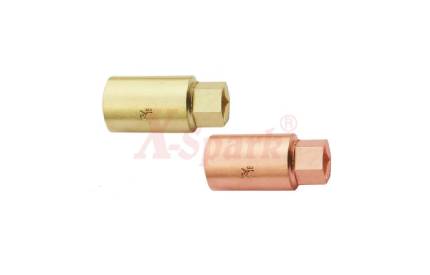1: mechanical life
Non-sparking safety tools mechanical life refers to the plug life, usually specified as 500 to 1000 times. When the specified mechanical life is reached, the contact resistance, insulation resistance and withstand voltage of the aviation plug should not exceed the specified values. Strictly speaking, mechanical life is a vague concept. Mechanical life should have a certain relationship with time, 500 times in 10 years and 500 times in 1 year, obviously the situation is different. It's just that there is no more economical and scientific method to measure it.
2: Number of contact pairs and pinhole
The spark-proof explosion-proof plug and socket are the first choice. The number of contact pairs can be selected according to the needs of the circuit. At the same time, the size of the electrical connector and the total separation force must be considered. The larger the number of contact pairs, the larger the volume, and the larger the total separation force. In some cases where reliability is high and volume is allowed, two pairs of contact pairs can be used in parallel to improve the reliability of the connection. In the plugs and sockets of aviation plugs, the pins (male contacts) and jacks (female contacts) are generally interchangeable. In actual use, it can be selected according to the charged condition of the plug and the socket. If the socket needs to be always charged, you can choose a socket with a jack, because the socket with a jack has its live contacts buried in the insulator, and it is relatively safe for the human body to touch the live contacts.
3: vibration, shock, collision
It mainly considers the electrical continuity of contact pairs during non-sparking socket vibration shock, impact, and collision under the specified frequency and acceleration conditions. Under this dynamic stress condition, the contact pair will momentarily break. The specified instantaneous break times are generally 1 μs, 10 μs, 100 μs, 1 ms, and 10 ms. It should be noted how to judge that the contact pair has an instantaneous fault. It is generally believed that when the voltage drop across the closed contact pair (contact) exceeds 50% of the power electromotive force, it can be determined that the closed contact pair (contact) has failed. In other words, there are two conditions for judging whether a momentary interruption occurs: duration and voltage drop, both of which are indispensable.

Non-Sparking Socket
4: Connection method
Non-sparking double end socket is generally composed of a plug and a socket. The plug is also called a free-end aviation plug, and the socket is also called a fixed aviation plug. Circuits are connected and disconnected through plugs, sockets, and mating and separation, thus creating various ways of connecting plugs and sockets. For round aviation plugs, there are three main methods: threaded connection, bayonet connection and marble connection. Among them, the threaded connection is the most common. It has the advantages of simple processing technology, low manufacturing cost, and wide range of applications. A bayonet connection has a longer lead time due to its three bayonet slots, so the connection is faster, but it is more complicated to manufacture and the cost is higher. The marble type connection is the fastest connection among the three connection methods. It does not need to perform rotary motion, and only needs to perform linear motion to achieve the functions of connection, separation and locking. Because it is a direct push-pull connection, it is only suitable for aviation plugs with a small total separation force. Generally more common in small aviation plugs.